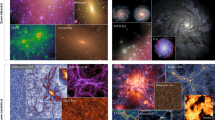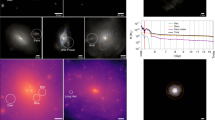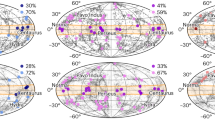Abstract
Future astronomical surveys will gather information that will allow gravity to be tested on cosmological scales, where general relativity is currently poorly constrained. We present a set of cosmological hydrodynamical simulations that follow galaxy formation in f(R) modified gravity models and are dedicated to finding observational signatures to help distinguish general relativity from alternatives using this information. The simulations employ the IllustrisTNG model and a new modified gravity solver in AREPO, allowing the interplay of baryonic feedback and modified gravity to be studied in the same simulation, and the degeneracy between them in the matter power spectrum to be resolved. We find that the neutral hydrogen power spectrum is suppressed substantially in f(R) gravity, which allows this model to be constrained using upcoming data from the Square Kilometre Array. Disk galaxies can form in our f(R) gravity simulations, even in the partially screened regime, and their galaxy stellar properties are only mildly affected. We conclude that modified gravity allows the formation of realistic galaxies and leaves observable signatures on large scales.
This is a preview of subscription content, access via your institution
Access options
Access Nature and 54 other Nature Portfolio journals
Get Nature+, our best-value online-access subscription
$29.99 / 30 days
cancel any time
Subscribe to this journal
Receive 12 digital issues and online access to articles
$119.00 per year
only $9.92 per issue
Buy this article
- Purchase on Springer Link
- Instant access to full article PDF
Prices may be subject to local taxes which are calculated during checkout




Similar content being viewed by others
Data availability
The data that support the plots within this paper and other findings of this study are available from the corresponding author upon reasonable request.
Code availability
The simulation code AREPO21 is currently not publicly available. The analysis scripts used to analyse the simulation output can be made available to the reader on request.
References
Buchdahl, H. A. Non-linear Lagrangians and cosmological theory. Mon. Not. R. Astron. Soc. 150, 1–8 (1970).
Lombriser, L. & Taylor, A. Breaking a dark degeneracy with gravitational waves. J. Cosmol. Astropart. Phys. 2016, 031 (2016).
Sakstein, J. & Jain, B. Implications of the neutron star merger GW170817 for cosmological scalar-tensor theories. Phys. Rev. Lett. 119, 251303 (2017).
Ezquiaga, J. M. & Zumalacárregui, M. Dark energy after GW170817: dead ends and the road ahead. Phys. Rev. Lett. 119, 251304 (2017).
Lombriser, L. & Lima, N. A. Challenges to self-acceleration in modified gravity from gravitational waves and large-scale structure. Phys. Lett. B 765, 382–385 (2017).
Khoury, J. & Weltman, A. Chameleon cosmology. Phys. Rev. D 69, 044026 (2004).
Will, C. M. The confrontation between general relativity and experiment. Living Rev. Relativ. 17, 4 (2014).
Hu, W. & Sawicki, I. Models of f(R) cosmic acceleration that evade Solar System tests. Phys. Rev. D 76, 064004 (2007).
Sotiriou, T. P. & Faraoni, V. f(R) theories of gravity. Rev. Mod. Phys. 82, 451–497 (2010).
Schmidt, F. Dynamical masses in modified gravity. Phys. Rev. D 81, 103002 (2010).
Zhao, G.-B., Li, B. & Koyama, K. Testing gravity using the environmental dependence of dark matter halos. Phys. Rev. Lett. 107, 071303 (2011).
Lombriser, L., Li, B., Koyama, K. & Zhao, G.-B. Modeling halo mass functions in chameleon f(R) gravity. Phys. Rev. D 87, 123511 (2013).
Puchwein, E., Baldi, M. & Springel, V. Modified-gravity-GADGET: a new code for cosmological hydrodynamical simulations of modified gravity models. Mon. Not. R. Astron. Soc. 436, 348–360 (2013).
Hellwing, W. A., Li, B., Frenk, C. S. & Cole, S. Hierarchical clustering in chameleon f(R) gravity. Mon. Not. R. Astron. Soc. 435, 2806–2821 (2013).
Zivick, P., Sutter, P. M., Wandelt, B. D., Li, B. & Lam, T. Y. Using cosmic voids to distinguish f(R) gravity in future galaxy surveys. Mon. Not. R. Astron. Soc. 451, 4215–4222 (2015).
Mitchell, M. A., He, J.-h, Arnold, C. & Li, B. A general framework to test gravity using galaxy clusters—I. Modelling the dynamical mass of haloes in f(R) gravity. Mon. Not. R. Astron. Soc. 477, 1133–1152 (2018).
Li, B. & Shirasaki, M. Galaxy–galaxy weak gravitational lensing in f(R) gravity. Mon. Not. R. Astron. Soc. 474, 3599–3614 (2018).
Arnold, C., Puchwein, E. & Springel, V. The Lyman α forest in f(R) modified gravity. Mon. Not. R. Astron. Soc. 448, 2275–2283 (2015).
Hammami, A., Llinares, C., Mota, D. F. & Winther, H. A. Hydrodynamic effects in the symmetron and f(R)-gravity models. Mon. Not. R. Astron. Soc. 449, 3635–3644 (2015).
He, J.-h & Li, B. Accurate method of modeling cluster scaling relations in modified gravity. Phys. Rev. D 93, 123512 (2016).
Springel, V. E pur si muove: Galilean-invariant cosmological hydrodynamical simulations on a moving mesh. Mon. Not. R. Astron. Soc. 401, 791–851 (2010).
Pillepich, A. et al. First results from the IllustrisTNG simulations: the stellar mass content of groups and clusters of galaxies. Mon. Not. R. Astron. Soc. 475, 648–675 (2018).
Springel, V. et al. First results from the IllustrisTNG simulations: matter and galaxy clustering. Mon. Not. R. Astron. Soc. 475, 676–698 (2018).
Genel, S. et al. The size evolution of star-forming and quenched galaxies in the IllustrisTNG simulation. Mon. Not. R. Astron. Soc. 474, 3976–3996 (2018).
Marinacci, F. et al. First results from the IllustrisTNG simulations: radio haloes and magnetic fields. Mon. Not. R. Astron. Soc. 480, 5113–5139 (2018).
Nelson, D. et al. First results from the IllustrisTNG simulations: the galaxy colour bimodality. Mon. Not. R. Astron. Soc. 475, 624–647 (2018).
Terukina, A. et al. Testing chameleon gravity with the Coma cluster. J. Cosmol. Astropart. Phys. 4, 013 (2014).
Arnold, C., Fosalba, P., Springel, V., Puchwein, E. & Blot, L. The modified gravity lightcone simulation project I: statistics of matter and halo distributions. Mon. Not. R. Astron. Soc. 483, 790–805 (2019).
Hellwing, W. A. et al. The effect of baryons on redshift space distortions and cosmic density and velocity fields in the EAGLE simulation. Mon. Not. R. Astron. Soc. 461, L11–L15 (2016).
Laureijs, R. et al. Euclid definition study report. Preprint at https://arxiv.org/abs/1110.3193 (2011).
Weinberger, R. et al. Simulating galaxy formation with black hole driven thermal and kinetic feedback. Mon. Not. R. Astron. Soc. 465, 3291–3308 (2017).
Winther, H. A. et al. Modified gravity N-body code comparison project. Mon. Not. R. Astron. Soc. 454, 4208–4234 (2015).
Villaescusa-Navarro, F. et al. Ingredients for 21 cm intensity mapping. Astrophys. J. 866, 135 (2018).
Santos, M. et al. Cosmology from a SKA H i intensity mapping survey. In Proc. Advancing Astrophysics with the Square Kilometre Array (AASKA14) 19 (2015).
Pillepich, A. et al. Simulating galaxy formation with the IllustrisTNG model. Mon. Not. R. Astron. Soc. 473, 4077–4106 (2018).
Altay, G., Theuns, T., Schaye, J., Booth, C. M. & Dalla Vecchia, C. The impact of different physical processes on the statistics of Lyman-limit and damped Lyman α absorbers. Mon. Not. R. Astron. Soc. 436, 2689–2707 (2013).
Behroozi, P. S., Wechsler, R. H. & Conroy, C. The average star formation histories of galaxies in dark matter halos from z = 0–8. Astrophys. J. 770, 57 (2013).
Giodini, S. et al. Stellar and total baryon mass fractions in groups and clusters since redshift 1. Astrophys. J. 703, 982–993 (2009).
Lovisari, L., Reiprich, T. H. & Schellenberger, G. Scaling properties of a complete X-ray selected galaxy group sample. Astron. Astrophys. 573, A118 (2015).
Planck Collaboration et al. Planck 2015 results. XIII. Cosmological parameters. Astron. Astrophys. 594, A13 (2016).
Vogelsberger, M. et al. Properties of galaxies reproduced by a hydrodynamic simulation. Nature 509, 177–182 (2014).
Vogelsberger, M. et al. Introducing the illustris project: simulating the coevolution of dark and visible matter in the Universe. Mon. Not. R. Astron. Soc. 444, 1518–1547 (2014).
Sawicki, I. & Bellini, E. Limits of quasistatic approximation in modified-gravity cosmologies. Phys. Rev. D. 92, 084061 (2015).
He, J.-h, Guzzo, L., Li, B. & Baugh, C. M. No evidence for modifications of gravity from galaxy motions on cosmological scales. Nat. Astron. 2, 967–972 (2018).
Springel, V. The cosmological simulation code GADGET-2. Mon. Not. R. Astron. Soc. 364, 1105–1134 (2005).
Li, B., Zhao, G.-B., Teyssier, R. & Koyama, K. ECOSMOG: an efficient code for simulating modified gravity. J. Cosmol. Astropart. Phys. 1, 51 (2012).
Bose, S. et al. Speeding up N-body simulations of modified gravity: chameleon screening models. J. Cosmol. Astropart. Phys. 2017, 050 (2017).
Llinares, C., Mota, D. F. & Winther, H. A. ISIS: a new N-body cosmological code with scalar fields based on RAMSES. Code presentation and application to the shapes of clusters. Astron. Astrophys. 562, A78 (2014).
Press, W. H., Teukolsky, S. A., Vetterling, W. T. & Flannery, B. P. (eds) Numerical Recipes 3rd edn (Cambridge Univ. Press, 2007).
Arnold, C., Springel, V. & Puchwein, E. Zoomed cosmological simulations of Milky Way-sized haloes in f(R) gravity. Mon. Not. R. Astron. Soc. 462, 1530–1541 (2016).
Ferrero, I. et al. Size matters: abundance matching, galaxy sizes, and the Tully–Fisher relation in EAGLE. Mon. Not. R. Astron. Soc. 464, 4736–4746 (2017).
Benitez-Llambay, A. Py-SPHviewer version 1.0.0, https://doi.org/10.5281/zenodo.21703 (2015).
Schaye, J. et al. The EAGLE project: simulating the evolution and assembly of galaxies and their environments. Mon. Not. R. Astron. Soc. 446, 521–554 (2015).
D’Souza, R., Vegetti, S. & Kauffmann, G. The massive end of the stellar mass function. Mon. Not. R. Astron. Soc. 454, 4027–4036 (2015).
Bernardi, M. et al. The massive end of the luminosity and stellar mass functions: dependence on the fit to the light profile. Mon. Not. R. Astron. Soc. 436, 697–704 (2013).
Baldry, I. K. et al. Galaxy and mass assembly (GAMA): the galaxy stellar mass function at z < 0.06. Mon. Not. R. Astron. Soc. 421, 621–634 (2012).
Acknowledgements
We thank the IllustrisTNG collaboration for allowing us to use their baryonic model to carry out the simulations presented in this work. We are grateful to V. Springel and R. Weinberger for their help with the AREPO code and for discussions on the results, and to A. Benitez-Llambay for making Py-SPHViewer52 available. Special thanks to C. Frenk and J. He for their comments on the results. The work described in this paper is supported by the European Research Council through an ERC Starting Grant (ERC-StG-716532-PUNCA). B.L. is additionally supported by STFC consolidated grants ST/P000541/1 and ST/L00075X/1. The cosmological simulations described in this work were run on the DiRAC Data Centric System at Durham University, UK, operated by the Institute for Computational Cosmology on behalf of the STFC DiRAC HPC Facility (www.dirac.ac.uk). This equipment was funded by BIS National E-infrastructure capital grant ST/K00042X/1, STFC capital grants ST/H008519/1 and ST/K00087X/1, STFC DiRAC operations grant ST/K003267/1 and Durham University. DiRAC is part of the National E-Infrastructure.
Author information
Authors and Affiliations
Contributions
C.A. and B.L. planned the project. C.A. developed, implemented and optimized (together with B.L.) the modified gravity solver AREPO, ran the simulations and performed the main part of the analysis. M.L. performed the analysis for the H i power spectrum. C.A., B.L. and M.L. interpreted the results. C.A. wrote the manuscript with contributions from M.L. and B.L.
Corresponding author
Ethics declarations
Competing interests
The authors declare no competing interests.
Additional information
Peer review information: Nature Astronomy thanks Simeon Bird, Bridget Falck and the other, anonymous, reviewer(s) for their contribution to the peer review of this work.
Publisher’s note: Springer Nature remains neutral with regard to jurisdictional claims in published maps and institutional affiliations.
Supplementary information
Supplementary Information
Supplementary Fig. 1 and Supplementary references 1–6.
Rights and permissions
About this article
Cite this article
Arnold, C., Leo, M. & Li, B. Realistic simulations of galaxy formation in f(R) modified gravity. Nat Astron 3, 945–954 (2019). https://doi.org/10.1038/s41550-019-0823-y
Received:
Accepted:
Published:
Issue Date:
DOI: https://doi.org/10.1038/s41550-019-0823-y
This article is cited by
-
Large-scale dark matter simulations
Living Reviews in Computational Astrophysics (2022)
-
Cosmological simulations of galaxy formation
Nature Reviews Physics (2020)
-
Behind the screen
Nature Astronomy (2019)



